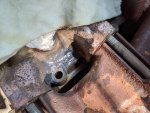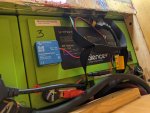In contrast I also have a ‘97 E350 Ambo. We bought it about 8 years ago. It’s a heavy rig that was maintained sparing no expense for the first 10 years & 200k miles. For the next 7 years & 35k miles it was privately owned and had some maintenance, but it needed an alternator and a rear spring pack when we bought it.
We bought it for $1000, replaced the alternator, rear springs, and all the brakes (& a couple brake lines).The O-rings on the fuel bowl needed to be replaced in the first year & I replaced the fuel filter at the same time. The glow plug relay housing was cracked and it didn’t work, so it was replaced. For comfort we’ve replaced the front coils with progressive coils, and shocks with Bilstein shocks. It’s needed upper and lower ball joint’s, a wheel alignment. When the vacuum pump was getting noisy I replaced it with an aftermarket one. A year or so later I replaced it again with a Re manufactured one because the aftermarket one had never performed great, and wasn’t able to create enough vacuum at idle. I got a mountain of parts for free so I ended up swapping in an ‘01 booster & master, and an ignition switch.
Aside from those things, I found 6 rims that hadn’t even been installed on a vehicle for $100 so I had tires mounted on them which eliminated the shimmy at around 70 mph. It has a seam or two in the roof that leaked. I replaced the flooring in the back, have added seats, and done a basic build. Now it’ll cruise along smoothly and drives as well as many new vans (perhaps even better).
Maintenance hasn’t been any more than a newer vehicle. It needs oil changes, batteries, tires, etc. but nothing unusual. One rear axle seal leaked and I replaced the bearings while it was apart. An emergency brake cable was very stiff and the end eventually broke off the cable. Also one of the front brakes needed to be cleaned up at one point because the brake was dragging. Again, nothing unusual for a van that sat for a while.
By now you’re wondering what’s my point. My point is that unless you buy a new van with a warranty, it’ll need some work and maintenance. If you buy a well maintained rig it’ll need some work, but it can be very reliable. If there’s been some neglected maintenance & hard use, the worn out parts will need to be replaced and maintenance caught up. Wether a rig is a ‘74, ‘93 (like the op), a ‘97, or even say a 2017, it’ll need maintenance and attention. The year alone isn’t what I’d be most concerned about… but age, mileage, and maintenance are all considerations.
Anyone getting into this sort of things should expect about $1000 a year in maintenance regardless of the age. If you are mechanically inclined you’ll save money, otherwise you’ll need to have deeper pockets. Also keep in mind that a low price may not be a great deal… but paying more won’t necessarily be better. ?











